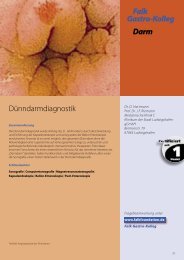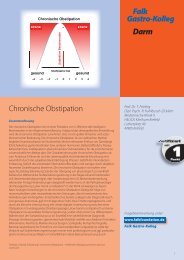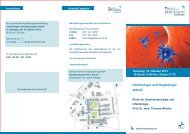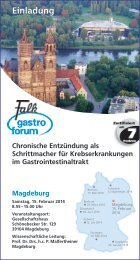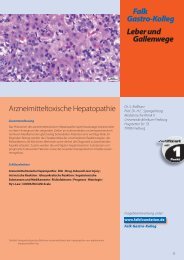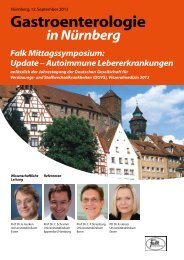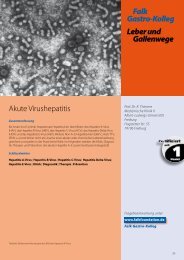152 153 Intestinal Disease Meeting Berlin 2006 - Dr. Falk Pharma ...
152 153 Intestinal Disease Meeting Berlin 2006 - Dr. Falk Pharma ...
152 153 Intestinal Disease Meeting Berlin 2006 - Dr. Falk Pharma ...
Create successful ePaper yourself
Turn your PDF publications into a flip-book with our unique Google optimized e-Paper software.
Congress Short Report <strong>Falk</strong> Symposium <strong>152</strong><br />
H.-J. Schulz J. Špičák<br />
The risks are higher with ERCP<br />
The risk of complications is significantly higher<br />
with ERCP than with polypectomy, said<br />
H.-J. Schulz (<strong>Berlin</strong>), noting that the most<br />
common and the most serious complication<br />
is pancreatitis. Pancreatitis takes a severe course<br />
in 10–15% of cases and pancreatitis is the most<br />
common cause of death following ERCP. Risk<br />
factors include female gender, sphincter of<br />
Oddi dysfunction and pre-existing pancreatitis<br />
(figure 16). Further complications include bleeding,<br />
cholangitis and perforation. Added to this<br />
are the complications secondary to sedation.<br />
The risk of complications is different for diagnostic<br />
and therapeutic ERCP; the rate of complications<br />
is necessarily higher with the latter. Complications<br />
for the most part relate to the sphincterotomy<br />
and in general depend on the extent<br />
of the procedure. Hence, one should avoid diagnostic<br />
ERCP in cases in which less invasive procedures<br />
can provide the required data.<br />
Perforation is the main risk in<br />
patients undergoing dilatation<br />
Unlike polypectomy and ERCP, the most common<br />
complication of endoscopic dilatation is<br />
perforation. In general, however, endoscopic<br />
dilatation, said J. Špičák (Prague), is considered<br />
an established procedure that can be safely used<br />
in practically all forms of strictures and stenoses<br />
of the gastrointestinal tract (figure 17), whether<br />
due to benign or malignant processes.<br />
Highly amenable to endoscopic treatment are<br />
stenoses associated with benign disorders of the<br />
esophagus and colon. Methods include balloon<br />
dilatation, use of sounds, electrocoagulation and<br />
the placement of temporary stents, or even a<br />
combination of these different techniques,<br />
J. Špičák said.<br />
21



